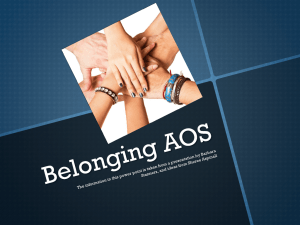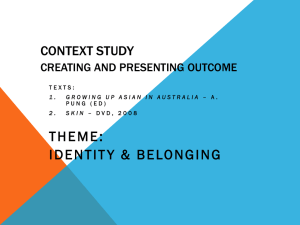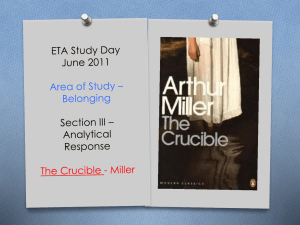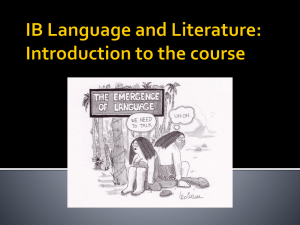The Craft of Writing
advertisement
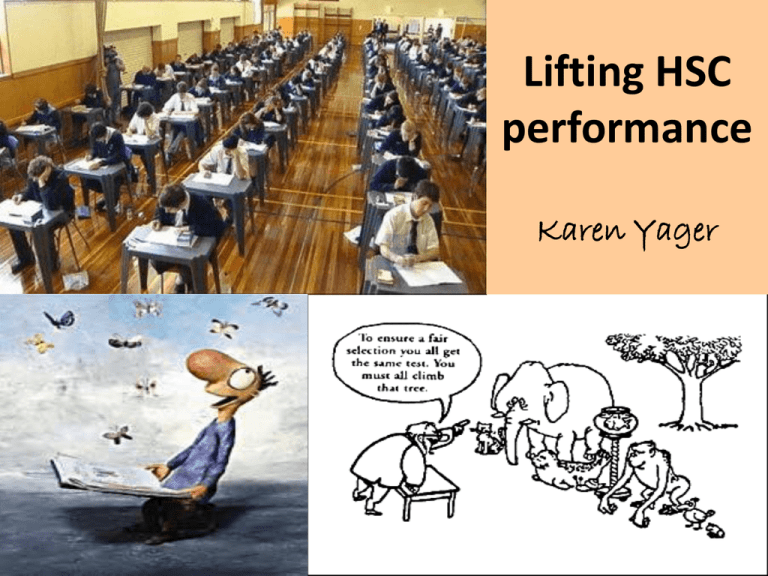
Lifting HSC performance Karen Yager Metacognition ‘If our aim is to improve student performance, not just measure it, we must ensure that students know the performances expected of them, the standards against which they will be judged, and have opportunities to learn from the assessment in future assessments’ (Wiggins, 2002). Importance of Feedback “An expert teacher, mentor or coach can readily explain, demonstrate and detect flaws in performance. He or she can also identify talent and potential, and build on these. In contrast, trial and error learning or poor teaching are less effective and take longer. If performance flaws are not detected and corrected, these can become ingrained and will be much harder to eradicate later. Learners who don’t receive instruction, encouragement and correction can become disillusioned and quit due to lack of progress” (Dinham, Feedback on Feedback, 2008). Effective Feedback Precise Strategic Timely Frequent (Holmes & Papageourgiou, 2009) Encourages students to make the difference and do resubmits ‘Insert word’ Using the data Key Ingredients Focussing on the key concepts and demands of the rubrics Notes from the Marking Centre Annotated exemplar responses Practice, practice, practice….. A Skilful Perceptive B Effective Thoughtful C Sound D Limited E Elementary Meaning Perceptions: interplay of recognition and interpretation and is influenced by our preconceived ideas, memories, experiences and senses Meaning Text Meaning Meaning Composer Meaning Assumptions about belonging Meaning Context & Perspectives: personal, cultural, historical, social Meaning Representation of belonging through language features and ideas Context & Perspectives: personal, cultural, historical, social Responder Perceptions: interplay of recognition and interpretation and is influenced by our preconceived ideas, memories, experiences and senses The Concept of Belonging How do you view the notion of belonging? Do the texts invite you to belong to their worlds? How do the texts represent the concept of belonging? How does your perception and assumptions about belonging compare with that of the composers you are studying? Has your perspective been challenged or altered? What lines of argument have you developed as a result? The Concepts Representation: You need to explore, critically analyse and evaluate why and how the texts have used textual features and forms to shape meaning and influence responses. Contextualisation: How your personal, cultural, social and historical context affects your perspective of belonging. Integrate the significant aspects of context throughout your response. Interrelationships: You need to find other texts that enable you to make meaningful connections with your prescribed text. These texts of your own choosing should support and challenge how your prescribed text represents belonging ensuring that you can develop a range of informed theses or lines of argument. The Concepts Perceptions: You must take into consideration the composers’ contexts and your own context to appreciate how they interpret belonging and how you respond to this perception of belonging. Perception refers to the interplay of recognition and interpretation and is influenced by our preconceived ideas, memories, experiences and senses. It can alter and even distort how we view the notion of belonging. Section 1: Reading Task “Strong responses demonstrated perception and insight into the ideas embedded in the texts and supported a thesis with effective textual evidence.” “Weaker responses simply described the content of either the written or visual without linking them” “A discussion which focused primarily on language techniques often restricted the candidates’ opportunity to demonstrate their understanding of the ideas in the texts or to develop their ideas effectively” Reading Task The ideas! Composer’s purpose and attitude towards belonging How language features, form and structure represent belonging How students personally respond to the texts Section 1: Reading Task • How the composer shapes understanding of and the response to the concept of ‘Belonging’ Identify the feature Exemplify the feature Explain the impact of the feature Extrapolate by discussing why the composer used the feature Tactics - Highlighting Overarching theme Final question: Concept driven Line of argument in first topic sentence - Synthesis - Mini-essay - End with an evaluative statement Imaginative Writing Writing is a craft that can be learned and transformed to become artistry! Explicitly focus on the craft and artistry! Section II: Notes from Marking Centre ‘They demonstrated structural complexity, cohesion, the use of an authentic, sustained and engaging voice…mechanics of language, punctuation, sentence structure and paragraphing were applied skillfully in these responses’ 2007 Feedback. ‘They explored the ways relationships contribute to a sense of belonging with insight, complexity and/or subtlety. These responses displayed originality and artistry and the mechanics of language were applied skillfully’ 2009 Notes from the Marking Centre. Feedforward - Cohesion: The idea Setting Motif or extended metaphor Voice: Writing from experience Word choice Characterisation Feedforward Subtlety: - Tension - Ambivalence Voice: - Writing from experience - Word choice Feedforward Mechanics: - Syntax: varying length and beginnings - Imagery: figurative devices/synathaesia - Sound: euphony, discordance, disruption - Verbs not adjectivous There’s a nothingness on the horizon that watches and waits. Nothing. I turn around and look back at the empty beach. There is no other place I want to be. I see a set coming. Digging deep into the ocean I gain speed and push my way onto the wave. A great force pushes me on and on. A huge rush of adrenalin kicks in as I stand up and fly down the glassy face. For that split second nothing else matters. No thoughts in my mind about school or my future or anything. All that matters is here on this wave. I don’t care what will come next… Activities Flash fiction – 50 words with a motif and key idea The senses Recording writing 12 word novels A newspaper headline or recent event Using writers to model effective writing: http://www.randomhou se.co.uk/vintage/offthep age/extracts.htm Section III: Extended Response Must demonstrate understanding of key concepts and ideas of belonging from the rubrics and through the response to the texts Develop theses or lines of argument Choose texts that connect with concepts Notes from the Marking Centre Candidates who clearly understood the purpose of their texts were able to demonstrate conceptual understanding and respond personally. High-range responses … displayed an ability to evaluate and analyse. Better responses developed a thesis which demonstrated a strong conceptual understanding. HSC Examination Rubrics In your answer you will be assessed on how well you: demonstrate understanding of the concept of belonging in the context of your study analyse, explain and assess the ways belonging is represented in a variety of texts organise, develop and express ideas using language appropriate to audience, purpose and context Extended Responses Conceptual understanding: - The thesis or line of argument - In response to the question - The framework and drivers for extended responses - Integrates the response - Support and challenge Developing a Thesis Strong opening paragraphs that introduce clear lines of argument or theses that directly address the question. A response that is driven by a thesis connected to the question. Each successive point must further the thesis through textual analysis and support. Support or even challenge then thesis through the analysis of the text/s. Precise topic sentences that are connected to and build on the thesis. Developing a Thesis Judicious textual support: Detailed, relevant examples from the text/s rather than spurious, shallow examples. Supporting the analysis of language features with examples from the text/s and evaluating their impact on the responder. Never a shopping list of techniques! Developing a Thesis “from hour to hour we ripe and ripe, then from hour to hour we rot and rot“ (Touchstone, II.vi.). When developing theses students should consider that the notion of belonging is never fixed. It is constantly shifting depending on the individual’s experiences, emotional state and relationships with self and others. They need to consider how humanity’s flaws and qualities challenge and enrich belonging. Regard belonging as an ambivalent notion. Explore when and why individuals move between belonging, indifference and alienation. Ambivalence Alienation Belonging Theses Overarching through the question to specific lines of arguments. Supporting the thesis with the reasons why the student has arrived at this point of view. At least two – three supporting arguments used to further the thesis that addresses the question in the essay. E.g. The greatest barrier to belonging is the self: our perceptions, assumptions and degree of self-efficacy. Feelings of belonging are constantly changing due to societal pressures and expectations. Some individuals choose to change personally to conform and belong or to stand alone. This concept of belonging is conveyed through the representations of people and their relationships with others and the larger world in the play The Crucible and the film Social Network. Strong individuals choose not to belong to a society to preserve their individual and professional identity, and this can either enrich or challenge the values of a community or group. An individual may choose or be forced to not belong to society in order to preserve their identity and core values. Belonging is such an innate driving force, yet some individuals such as John Proctor in The Crucible because of a repressive and tragic context deliberately suppress this drive and choose alienation from society to find a more acceptable way to belong spiritually, ethically and morally to family, friends and self. Integration Making connections between the texts through: - The thesis - Characters - The act of representation Connecting words: Furthermore, alternatively… Lines of Arguments We spend our lives trying to belong to self, a place and others, not realising that it is our perceptions and attitudes that enable us to belong. When we begin to understand the forces that drive us to belong we develop empathy for others and personal insight. The simple act of unquestioning friendship and kindness nurtures the notion of belonging. When individuals experience a strong connection to a place the notion of belonging is strengthened and enriched. Ideas The pressure to belong and conform has the potential to threaten individuality and independent thought. Belonging to a community or a group is not always a positive thing. To maintain the cohesion, power and authority of the community or group, individuals could be forced to conform and suppress their individuality. Freedom and independence can become casualties of conformity. Theses We all need to find a community where we belong and we are accepted. A strong sense of identity ensures that an individual can deal with challenging circumstances. Belonging may be a fundamental human need but it also a choice: “I thank you for your company, but, good faith, I had as lief have been myself alone.” Suggested Approach Paragraph 1: Immediately address the question and introduce the thesis or line of argument that challenges or supports it. Provide at least one or two supporting arguments through an explanation of the thesis. Paragraph 2: Connect to the question and the thesis using a topic sentence. Then connect to the prescribed text by discussing whether the text supports or challenges the question. Briefly discuss the significance of the composer’s context and times, and his or her perspectives, and how these influence the text’s representation of belonging and the underlying assumptions of the text about belonging. Context can be integrated through out the analysis of a text. Suggested Approach Paragraphs 3 - 5: Connect the topic sentence to the previous paragraph and build on the thesis. Use the question and the associated thesis or line of argument to discuss those aspects of the text that are relevant. Integrate an analysis of the textual features and details that convey belonging. Use quotes from the text, but don’t use lengthy quotes that are not explained or linked to your discussion. Make connections with one or more of the other texts through the thesis, characters’ responses to belonging or language features used to represent belonging. Texts of own Choosing Discerning choice of related material that enhance and strengthen the argument through subtle comparison or stark contrast. Enable the student to support and challenge the theses or lines of argument Discuss the textual features with confidence and ease Way Home – Libby Hathorn Related Texts One Night the Moon: Prejudice destroys all hope of a family being reunited. Beneath Clouds: A community divided by racism. The Island: Unquestioning conformity and mob rule in its most ugly and destructive form. Children of Men: Dystopian film where Britain has become monocultural. Related Texts Catcher in the Rye: Holden chooses alienation because of the phoniness of others. Jasper Jones – Craig Silvey: ‘I think Jasper Jones speaks the truth in a community of liars.’ TS.Eliot: ‘The Waste Land’ Tim Winton: The Turning – short stories Related Texts Social Network: How relationships strengthen and challenge the notion of belonging. Diddy Dirty: “Coming Home”‘we back cruising through Harlem, Viso blocks it’s what made me, saved me, drove me crazy drove me away than embraced me forgave me for all of my shortcomings welcome to my homecoming’ Resources To access a range of essay questions visit: http://tutortales.wordpress.com/2009/07/16/practice -questions-for-area-of-study-belonging/#more-196 To find suggested texts of own choosing visit: http://www.thechimaera.com/May2008/Theme/Preface.html http://www.insidebreak.org.au/belonging/ http://hscbelonging.wordpress.com/2009/12/01/belo nging-to-a-place/ Support Mind maps Comparison/contrast tables Generic responses and then spotlighting Timed opening paragraphs Topic sentences Connecting paragraphs Module A: Texts in Time Frankenstein and Blade Runner "Art at its most significant is a distant early warning system that can always be relied on to tell the old culture what is beginning to happen” Marshall McLuhan. Both texts explore a dilemma that continues to resonate in the 21st century: the ethical and moral tension between the fear of humanity’s abuse of technology because of our inherent flaws such as ambition, ego, pride and greed, and the incredible potential for technology to extend life and even defy death. ‘What piece of work is a man?’. HSC Rubric In your answer you will be assessed on how well you: demonstrate understanding of the meanings of a pair of texts when considered together evaluate the relationships between texts and contexts organise, develop and express ideas using language appropriate to audience, purpose and form HSC Feedback “These responses embedded an evaluation of the relationship between text and context in the analysis of the texts” “incorporated an analysis of the ways in which a comparative study invited deeper understanding of the concepts suggested by the question” “clear understanding of how context influenced the values and ideas in both texts” Texts in Times Similar content: Humanity using technology to challenge nature and the limitations of life provides the narrative frame for both texts. Framing the response: A range of theses or lines of arguments Grounded in context, times and values Integrated through the meaning conveyed by the consideration of characterisation, setting, language features, ideas, etc in both texts. Texts in Time Framing the response: - The ethical and moral dilemma explored by both texts provides you with fertile ground for crafting an integrated comparison and contrast that considers explicitly the influence of times, contexts and values - The creators and the creations - The director and the observer - The ideas: mortality, humanity, identity, morality, exploitation - Leading to what you have discovered about these ideas after considering BOTH texts! “Both Blade Runner and Frankenstein question what it means to be human.” Evaluate how this question is explored in both texts and what meaning you have arrived at from this evaluation. Discuss the context and values and what is being said about humanity in the 19th and 20th century Humanity : imagination and intelligence, flawed, mortality, relationships, empathy and love Analyse in an integrated comparison and contrast the creators and the creations , and the ideas that are conveyed about what it means to be human. Discuss what meaning you have gained after an evaluation of what it means to be human in both texts. Thesis Both texts, through their representation of the lack of humanity in the creators, and the very human qualities and flaws of the creations, raise the question about what is a human. Context and Values Frankenstein Blade Runner Romantics: Freedom, individuality, sublime nature Industrial Age: expansion, child labour, slavery, enterprise, profit, technology, low life expectancy, crime Religion and Morals: conservative but decline of religion and morality Women: suppressed , death in child birth Multinationals: profit, advancement, enterprise Postmodern world: atomic warfare, evil, transitory nature of life, power struggle Technology: prolonging life, robotics, personal computers, weapons of war The Creators Frankenstein Blade Runner Victor: rebellious, intelligent, ambitious and driven, god-like “Prometheus was a fool. The gods were jealous, greedy and possessive.” “When I run over the frightful catalogue of my sins, I cannot believe that I am the same creature whose thoughts were once filled with sublime and transcendent visions of the beauty and the majesty of goodness. But it is even so; the fallen angel becomes a malignant devil. Yet even that enemy of God and man had friends and associates in his desolation; I am alone.” Tyrell: ambitious, blind, ignorant, cruel and lacks compassion. "Commerce is our goal here at Tyrell; more human than human is our motto!" A remote and god-like individual who resides in the penthouse floor of his corporation. Tyrell cannot conceive why replicants would expect to live beyond their predetermined life span of four years. The Creations The ‘creations’ of this technology in both texts raise many significant moral and ethical questions about what it is to be human. In Frankenstein, the monster is represented sympathetically as being intelligent and sensitive, but his experiences with humanity transform him into a dark creature. In Blade Runner, the opposite occurs as when we first meet the replicants they are cast in the role of villain, yet as the narrative unfolds we develop empathy for their plight. Despite their terrible deeds we realise that at times they were more human than their creators. The Monster Shelley creates a monster that is intelligent and sensitive. Influenced by John Locke’s 17th century essays that argued that when individuals are born they are neither good nor evil, but as they grow their attitudes, values and behavior are shaped by their early sensory experiences. Emerges as Adam but becomes the fallen angel hell-bent on revenge and retribution. The Monster The monster’s experience of cruel rejection by his creator is tempered by his observations of the kind and virtuous DeLacey family. “But my chief delights were the sight of the flowers, the birds, and all the gay apparel of summer” Bible, Plutarch’s Lives of the Noble Romans and Goethe’s The Sorrows of Werther teach him about the duplicitous nature of humanity. The Monster He is the archetypal outsider devoid of family and love, and doomed to be forever rejected and alone. - “No father had watched my infant days, no mother blessed me with smiles and kisses” - essay “Of Human Virtue” written in the 18th century by Godwin. This instigates self-loathing and a rejection of good, and an embracement of revenge and evil. He is last seen by the explorer Robert Walton heading north like Deckard and Rachel “borne away by the waves, and lost in darkness and distance”. Robert Walton Like Deckard, a narrator and a foil for Frankenstein. Explores the treacherous North Pole and find an Arctic passage to connect the Atlantic and Pacific Oceans. Raw, blind ambition and hubris prompts Frankenstein to relay his tale of woe and confront Walton with his flaws. He is pursuing that “country of eternal light”— unknown and illusive knowledge "How gladly would I sacrifice.” Roy Batty ‘All he wanted were the same answers any of us want …’ Deckard sees that Roy experiences the same doubts and worries, loves and mysteries, as his own. Endowed with strength and intelligence We acknowledge or deny humanity in the attitude we adopt towards the ‘other’. By living longer Roy hopes to become more human, by dying he becomes human. Roy Batty Sense of self preservation, love for Pris and the seeking out of Tyrell [his father] are all demonstrative of his humanity. At the end of his life Roy displays the most enlightened and transcendent of all human emotions, compassion and integrity. Like a Christ-like figure, Batty dies for the sins of humanity and the sin of being human hands an eloquent and moving soliloquy before he dies: “I’ve seen things you people wouldn’t believe…All those moments will be lost in time like tears in rain. Time to die.” Deckard Deckard has lost his humanity – too much killing and no relationships Cold, calculating, ruthless and suspicious Roy and Rachel teach him what it means to be human. Deckard is changed by Roy’s selfless act and his stoic acceptance of his death: “Maybe in those last moments, he loved life more than he had before. Not just his life, anybody’s life, my life.” Deckard acknowledges that the replicants are just as human, if not more human, than their masters. Distinctively Visual Henry Lawson’s short stories and related texts Landscape Harsh, vast and dry Isolated and dangerous Water offering life and renewal By the River Steven Herrick’s verse novel Brown was dry grass all summer, a dead snake, cane toads squashed flat, our house smeared in oil; nothing that lives, nothing that shines. Films No Country for Old Men True Grit The Road Australian Screen: film clips: http://aso.gov.au/titl es/alpha/A/ Songs ‘Sounds of then’ http://www.youtube. com/watch?v=tSxnv QeqnsE – gangajang ‘Droving Woman’ – Paul Kelly http://www.youtube. com/watch?v=5fm27 zZ4psw&feature=fvsr People Stoic, courageous and strong Resilient and feisty women Accepting and convivial men William Dobell – The Billy Boy Sydney Nolan – Ned Kelly Fredrick McCubbin Fredrick McCubbin Metho Drinker – Judith Wright Under the death of winter's leaves he lies who cried to Nothing and the terrible night to be his home and bread. "O take from me the weight and waterfall ceaseless Time that batters down my weakness; the knives of light whose thrust I cannot turn; the cruelty of human eyes that dare not touch nor pity." Under the worn leaves of the winter city safe in the house of Nothing now he lies. His white and burning girl, his woman of fire, creeps to his heart and sets a candle there to melt away the flesh that hides from bone, to eat the nerve that tethers him in time. He will lie warm until the bone is bare and on a dead dark moon he wakes alone. It was for Death he took her; death is but this; and yet he is uneasy under her kiss and winces from that acid of her desire. Bullocky – Judith Wright Beside his heavy-shouldered team, thirsty with drought and chilled with rain, he weathered all the striding years till they ran widdershins in his brain: Till the long solitary tracks etched deeper with each lurching load were populous before his eyes, and fiends and angels used his road. Night Ride – Kenneth Slessor Gas flaring on the yellow platform; voices running up and down; Milk-tins in cold dented silver; half-awake I stare, Pull up the blind, blink out - all sounds are drugged; the slow blowing of passengers asleep; engines yawning; water in heavy drips; Black, sinister travellers, lumbering up the station, one moment in the window, hooked over bags; hurrying, unknown faces - boxes with strange labels all groping clumsily to mysterious ends, out of the gaslight, dragged by private Fates, their echoes die. The dark train shakes and plunges; bells cry out, the night-ride starts again. Soon I shall look out into nothing but blackness, pale, windy fields, the old roar and knock of the rails melts in dull fury. Pull down the blind. Sleep. Sleep Nothing but grey, rushing rivers of bush outside. Gaslight and milk-cans. Of Rapptown I recall nothing else. Films Of Mice And Men To Kill a Mocking Bird O Brother Where Art Thou 127 Hours Yolongu Boy Storm Boy Songs ‘On Raglan Road’ – Sinead O’Connor http://www.youtube.c om/watch?v=T6zqb3g f5aA&feature=related ‘Streets of London’ Ralph McTell http://www.youtube.c om/watch?v=DiWomX klfv8&feature=related Preparation Comparison/contrast columns Mind maps Learning objects Recordings of texts Developing a solid general response and then practising being flexible by responding to a range of questions. Exercising the hand Choice of pen Coaching
